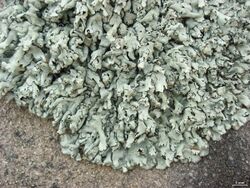Biology:Xanthoparmelia cumberlandia
| Xanthoparmelia cumberlandia | |
|---|---|

| |
| Scientific classification | |
| Domain: | Eukaryota |
| Kingdom: | Fungi |
| Division: | Ascomycota |
| Class: | Lecanoromycetes |
| Order: | Lecanorales |
| Family: | Parmeliaceae |
| Genus: | Xanthoparmelia |
| Species: | X. cumberlandia
|
| Binomial name | |
| Xanthoparmelia cumberlandia (Gyeln.) Hale (1974)
| |
| Synonyms | |
|
Parmelia cumberlandia Gyeln. | |
Xanthoparmelia cumberlandia is a lichen which belongs to the Xanthoparmelia genus. It is also known as a member of the rockfrong lichens due to its coloration.[2]
Description
Grows to around 6–12 cm in diameter with irregular lobate lobes. The upper surface of the lichen has rounded lobed tips with yellow-green or blueish green areas on the surface.[3]
Habitat and range
Commonly found attached to acid rocks in sheltered and semi-sheltered open coastal and intermontane areas at lower elevations as such it is commonly found in across North America except in deserts and open plains.[2][4][5][6]
Chemistry
Xanthoparmelia cumberlandia produces constictic, norstictic, stictic, norstictic, usnic and menegazzic acids.[7]
Taxonomy
The lichen was first formally described under the name Parmelia cumberlandia in 1847.[8]
See also
References
- ↑ "NatureServe Explorer - Xanthoparmelia cumberlandia". NatureServe. 2022-08-23. https://explorer.natureserve.org/Taxon/ELEMENT_GLOBAL.2.127444/Xanthoparmelia_cumberlandia.
- ↑ 2.0 2.1 Goward, Trevor (1994–1999). The lichens of British Columbia : illustrated keys. Bruce McCune, Dellis Vern Meidinger, British Columbia. Ministry of Forests. Research Branch. Victoria, B.C.: Ministry of Forests, Research Program. ISBN 0-7726-2194-2. OCLC 31651418. https://www.worldcat.org/oclc/31651418. Retrieved 2022-05-12.
- ↑ Lichen flora of the greater Sonoran Desert region. Thomas H., III Nash. Tempe, Ariz.: Lichens Unlimited, Arizona State University. 2002–2004. ISBN 0-9716759-0-2. OCLC 50120839. https://www.worldcat.org/oclc/50120839. Retrieved 2022-05-12.
- ↑ Pringle, Anne; Chen, Diana; Taylor, John W. (June 2003). [0221:sficts2.0.co;2 "Sexual Fecundity is Correlated to Size in the Lichenized Fungus Xanthoparmelia cumberlandia"]. The Bryologist 106 (2): 221–225. doi:10.1639/0007-2745(2003)106[0221:sficts2.0.co;2]. ISSN 0007-2745. http://dx.doi.org/10.1639/0007-2745(2003)106[0221:sficts]2.0.co;2. Retrieved 2022-05-12.
- ↑ "Cumberland Rock Shield (Xanthoparmelia cumberlandia)" (in en). https://www.inaturalist.org/taxa/123230-Xanthoparmelia-cumberlandia.
- ↑ "Xanthoparmelia cumberlandia (Gyelnik) Hale" (in en). https://www.gbif.org/species/2604642.
- ↑ Deduke, C.; Piercey-Normore, M. D. (July 2014). "A potential trade-off with stictic acid improves ascospore viability in Xanthoparmelia cumberlandia" (in en). The Bryologist 117 (3): 290–296. doi:10.1639/0007-2745-117.3.290. ISSN 0007-2745. http://www.bioone.org/doi/abs/10.1639/0007-2745-117.3.290. Retrieved 2022-05-12.
- ↑ Hale, Mason E. (1967). "New Taxa in Cetraria, Parmelia, and Parmeliopsis". The Bryologist 70 (4): 414–422. doi:10.2307/3240783. https://www.jstor.org/stable/3240783. Retrieved 2022-05-12.
Wikidata ☰ Q10721160 entry
 |


